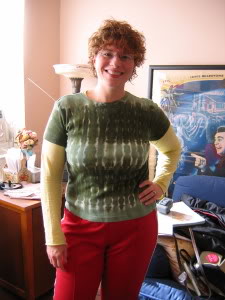Gina Kolata had a brief, interesting article in yesterday’s New York Times about the fact that, according to his BMI of 26.4, our vigorously healthy and virile President is overweight—putting him among the 65% of Americans who fall into this category. Your BMI, or Body Mass Index, is determined by a formula based on weight and height, nothing more. “Normal” is 18.5-24.9; “Overweight” is 25.0-29.9; and “Obese” is anything over 30. (You can calculate your BMI here, if you’re interested.) It doesn’t take into account any body measurements, or body fat percentages, or even body types, so a man who’s 5’10” and 200 pounds has a BMI of 28.7. That man is considered well on his way to obesity, even if he’s a muscular type with very little body fat. Most web sites, including the Centers for Disease Control’s own, will tell you that BMI is only one piece of information among several that indicate a healthy body weight. And yet it’s this one number that the National Institutes of Health use as the standard, the one number that creates all those alarming headlines about how fat we are as a nation.
When I was at my thinnest—when people were concerned that I was becoming anorexic—my BMI was 25.1: “Overweight.” I worked out A LOT. I was mostly muscle. I wore a size 10, and if I was lucky an 8. When I got married, it was 26.9: even more “overweight.” I wore a size 12, was quite fit, and felt great. Today, my BMI is an even 30: “OBESE.” Is this the body of an obese person?

My size 12 clothes mostly don’t fit, and I have a feeling if I were to cave and buy some new stuff I’d be looking at more like a 16. I feel fat, certainly, but saying I feel fat is a very different thing from being medically obese. Where, and how, do we draw that line?
The other number that used to get tossed around a lot (once the experts stopped relying on weight alone, that is) is Body Fat Percentage. For women, an “obese” percentage is over 32; “acceptable” is 24-31; “fit” is 21-24; and “athlete” is 14-20. At my leanest, with a BMI of 25.1—an overweight BMI—my body fat percentage was just over 15. I didn’t get my period for almost a year—as I discovered, a woman’s body will only menstruate when it has enough fat to sustain a pregnancy. When I got married, the percentage was just over 18. I have no idea what it is right now—my trainer used to measure me regularly, and I had to give him up to save money—but I’d guess it’s somewhere around 22. Are you confused yet? I know I am.
Possibly the most unreliable number in all of this is pure weight. The absolute least I ever weighed was 152. I weighed that little for exactly two weeks in December of 1997. That’s barely within Weight Watcher’s goal range for my height—in order to become a Lifetime Member, which indicates I’d reached goal and maintained it for a certain period of time, I had to get a doctor’s note increasing my goal to a more reasonable number for my body type. Several years ago, when I applied for a job at WW—I’d become a bit of an evangelist, and thought working for the organization would help me toe the line indefinitely—I discovered that this outside-the-guidelines figure disqualified me from employment there. Period. Even though I’d reached goal and stayed there, it wasn’t within the Official Weight Watchers Weight Range for my height so it wasn’t good enough. I cried when I got off the phone with them.
The thing that bothers me most about all this is how brainwashed we’ve all become to believe any of these numbers, taken individually, actually mean something. According to Weight Watchers, I’m not good enough unless I weigh a specific amount. According to NIH, I’m obese right now. According to most high-end designers, when I was at my happiest—when I felt the best, when I was able to maintain my weight and my workout, when my blood pressure was low and my health was pristine—my clothing size made me just barely acceptable. When, exactly, is any number good enough?
Since writing the “Debbie” installment of The Three Faces of Me, I’ve been thinking about this a lot—when I was most content, and why, and why I’m not so content right now. A certain amount of it comes from our culture, to be sure—these days it’s no fun to go shopping, knowing I’d be squeezing into a size 14. Most of the clothes I want to wear wouldn’t fit, or even come in my size. Instead I’d be looking for comfy waistbands and sleeves that cover my upper arms—shopping like a fat woman. But when I think back to all those years where I accepted myself as a size 24, I didn’t mind shopping at all—I knew what looked good on me, and had fun once I was inside the large-size stores. Walking in the door was the only traumatic part, and I think that’s part of my discomfort now: For the last seven years, every time I passed a Lane Bryant I smiled to myself, knowing without a doubt that I’ll never have to shop there again. If I continue on the path I’m waddling along these days, that may not turn out to be true, and it terrifies me.